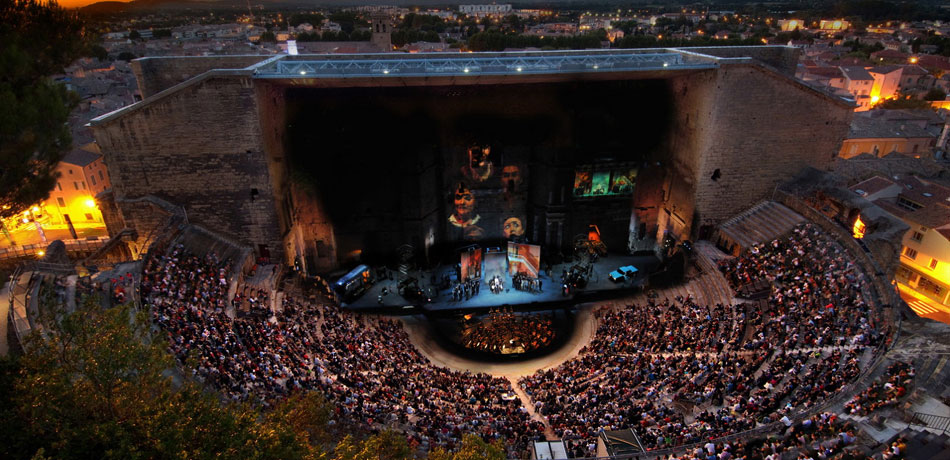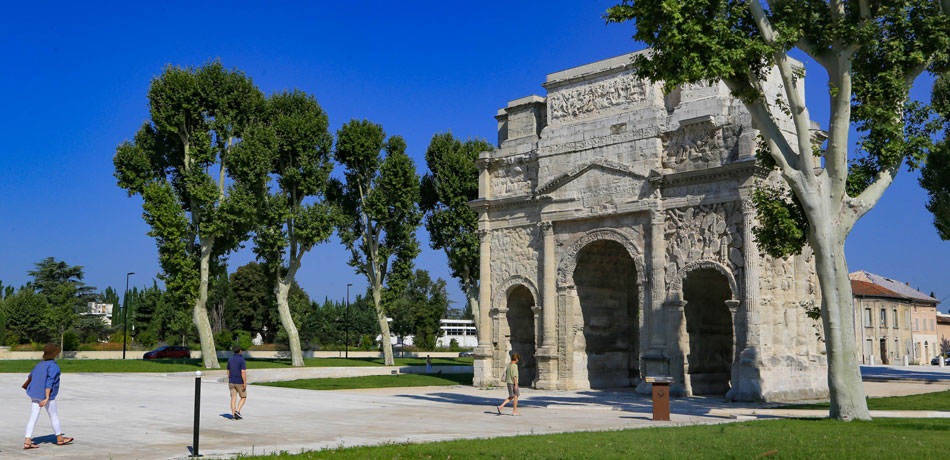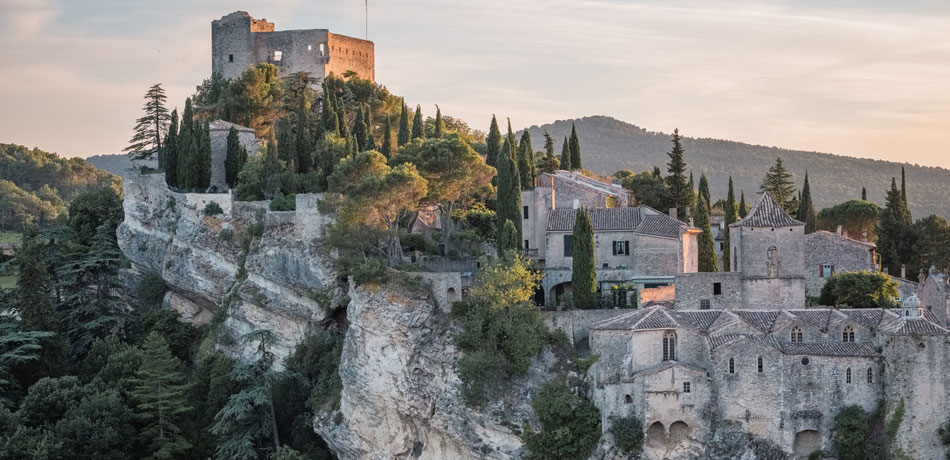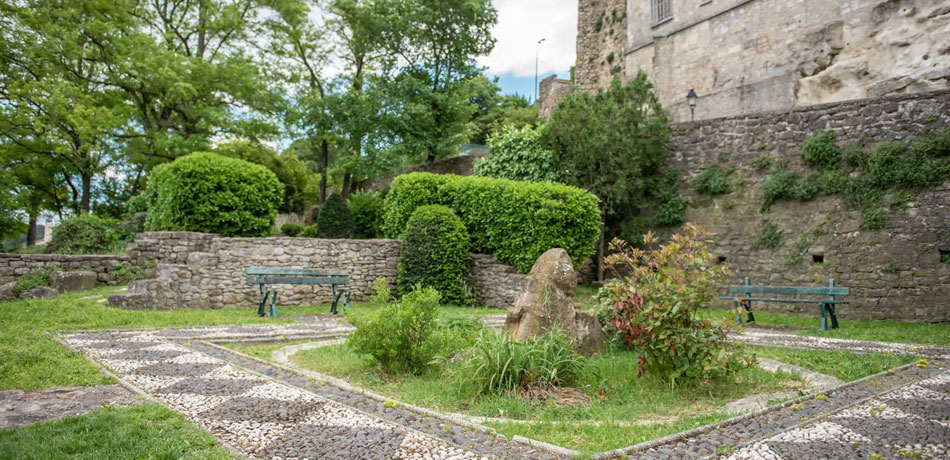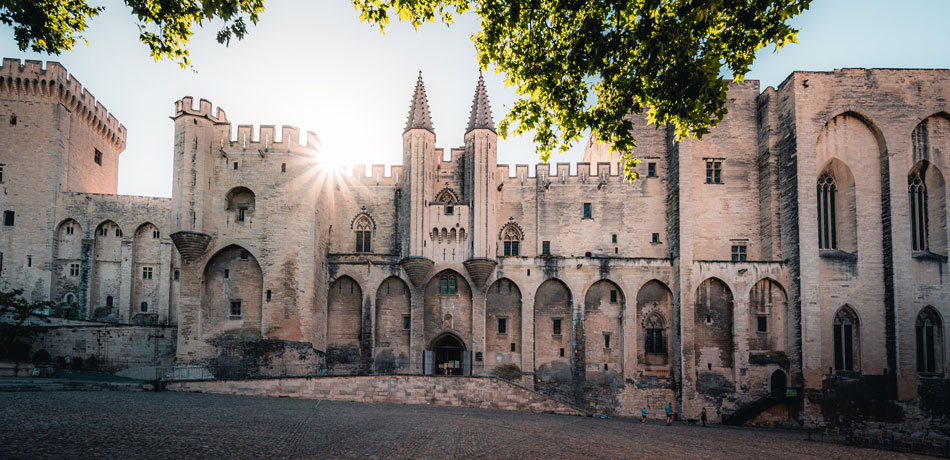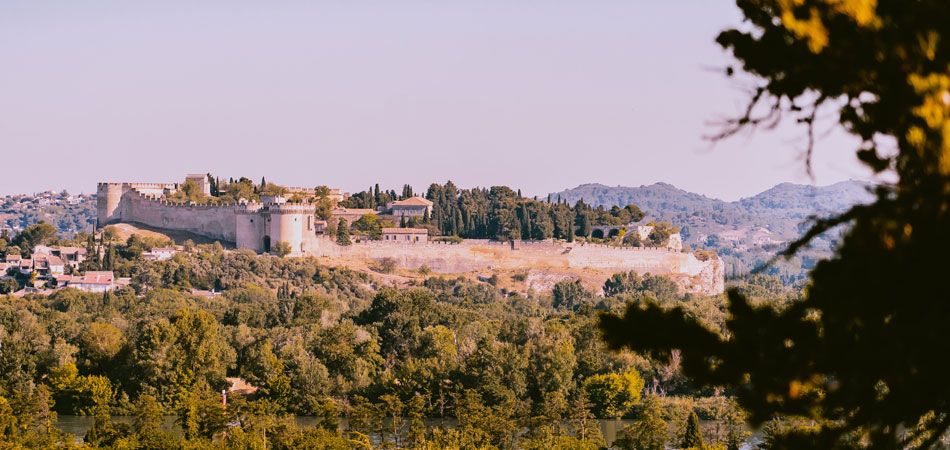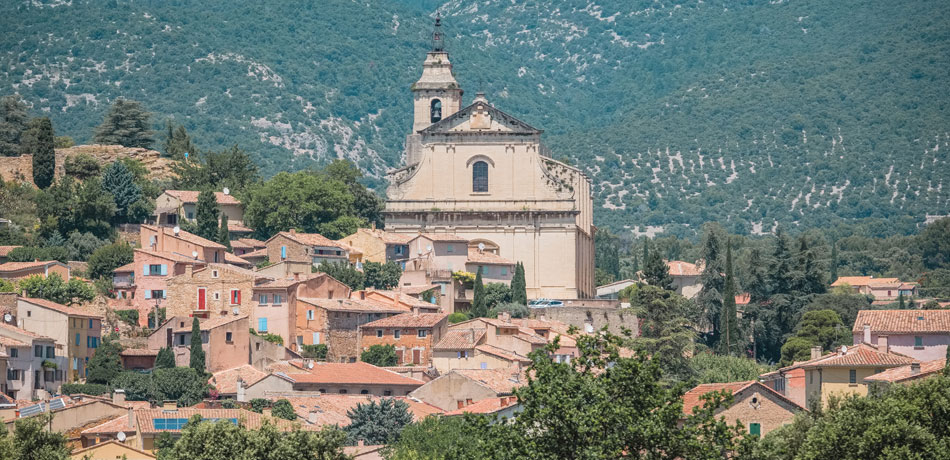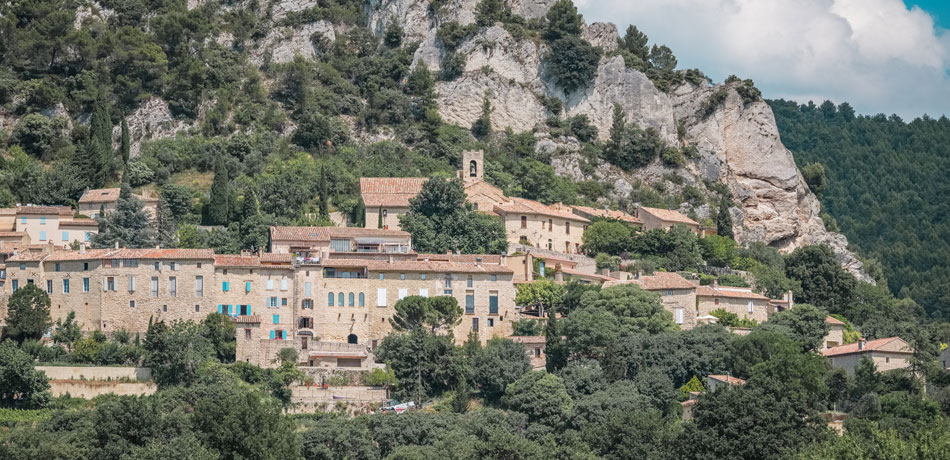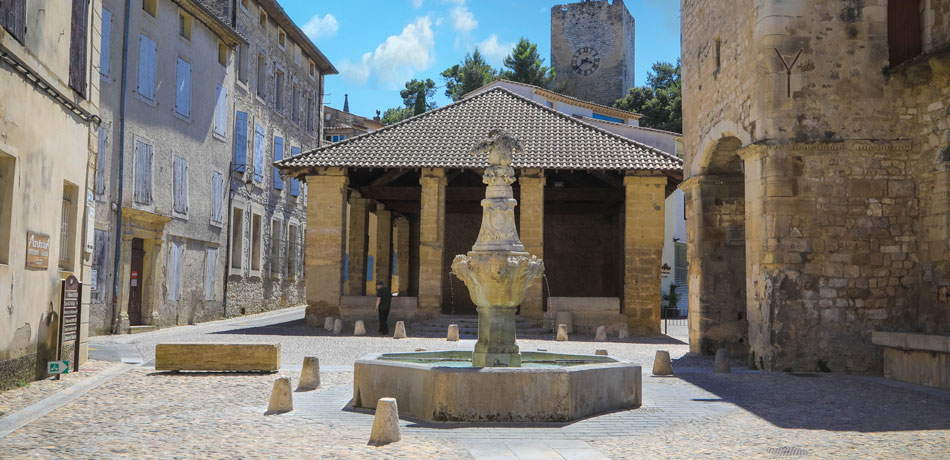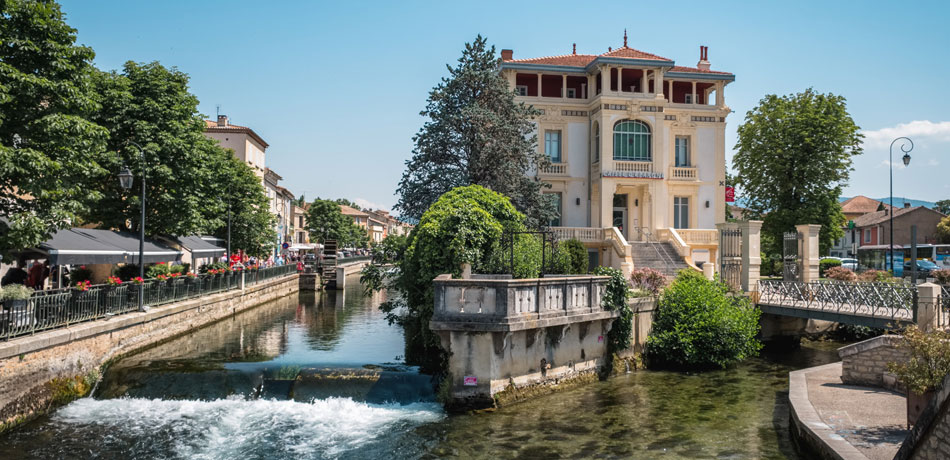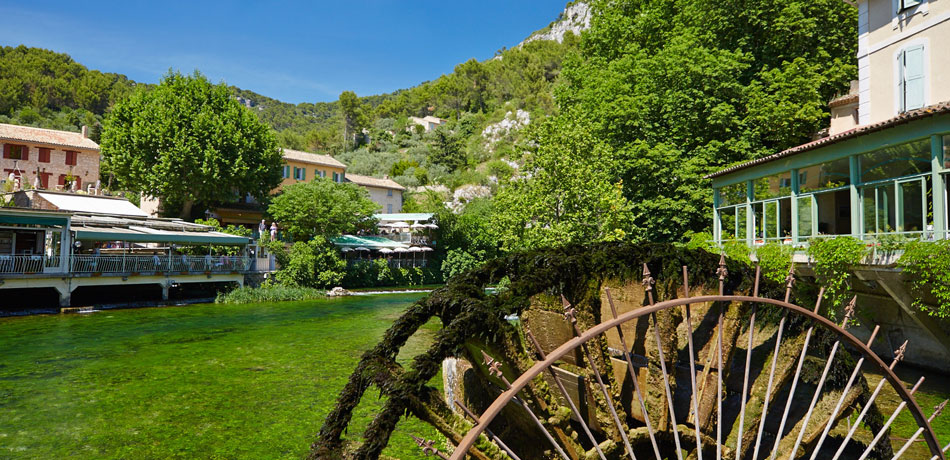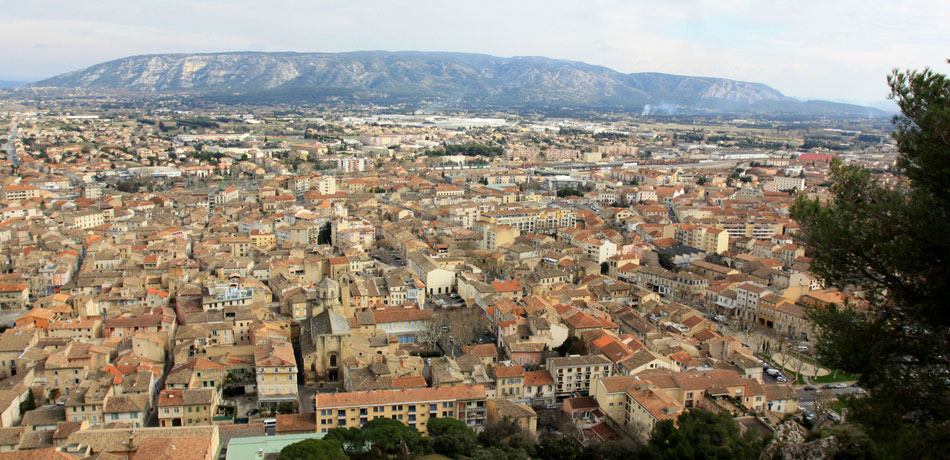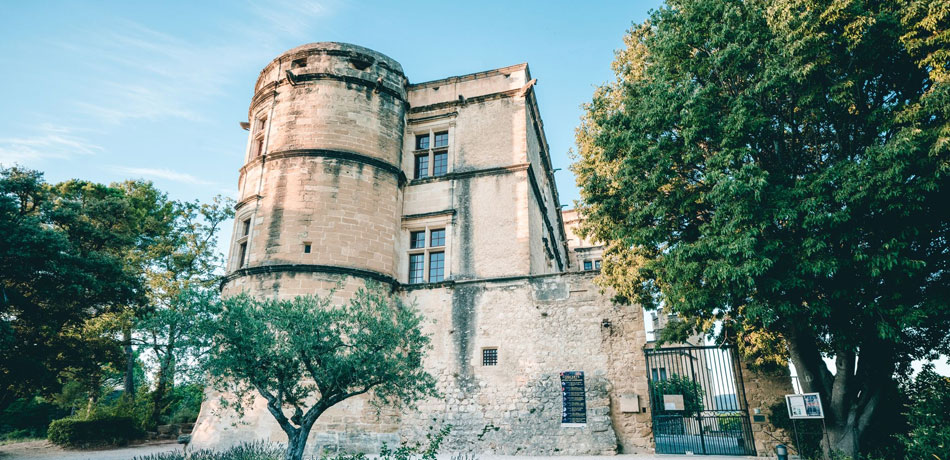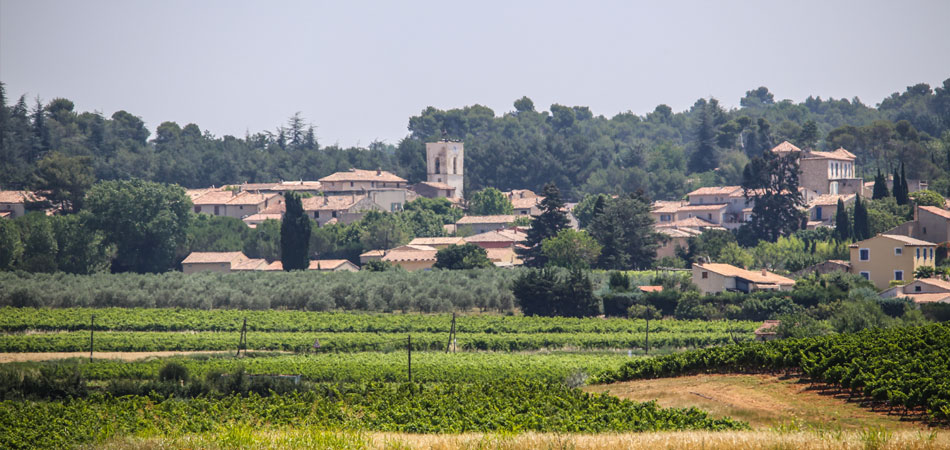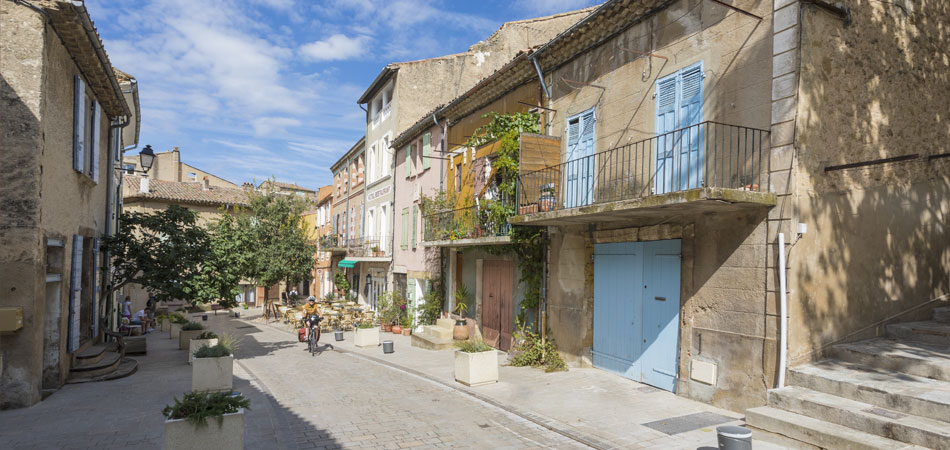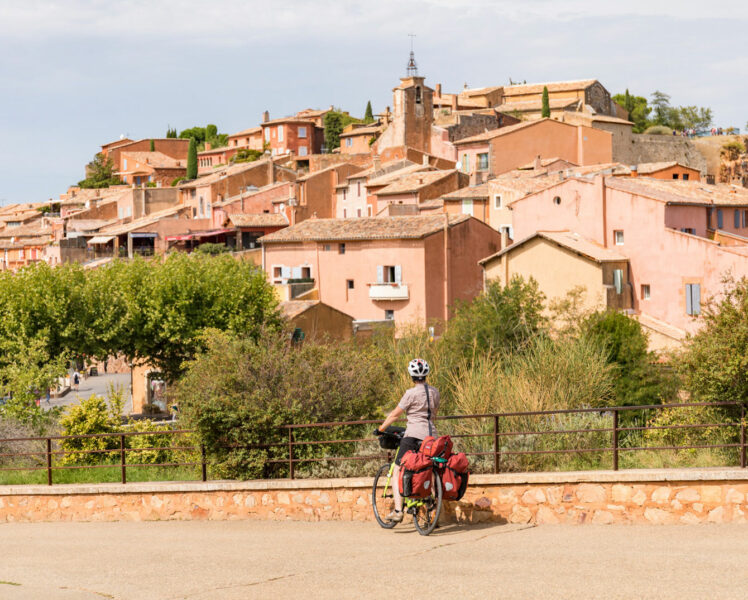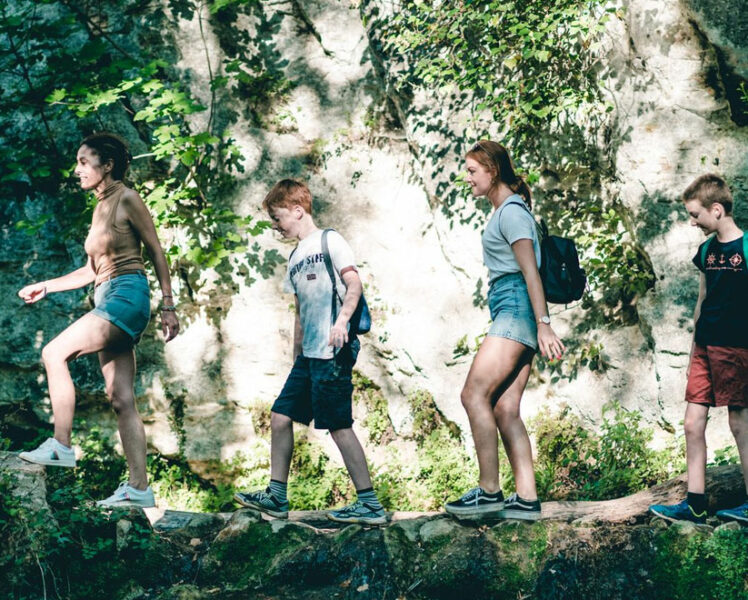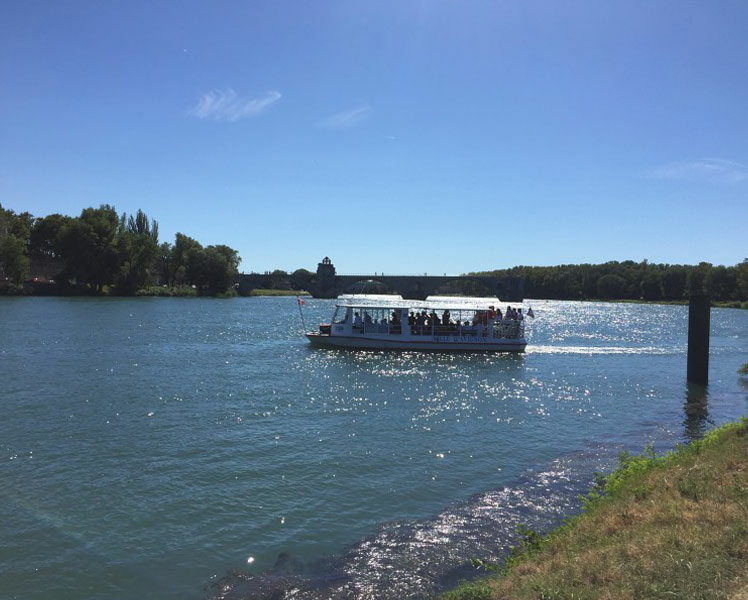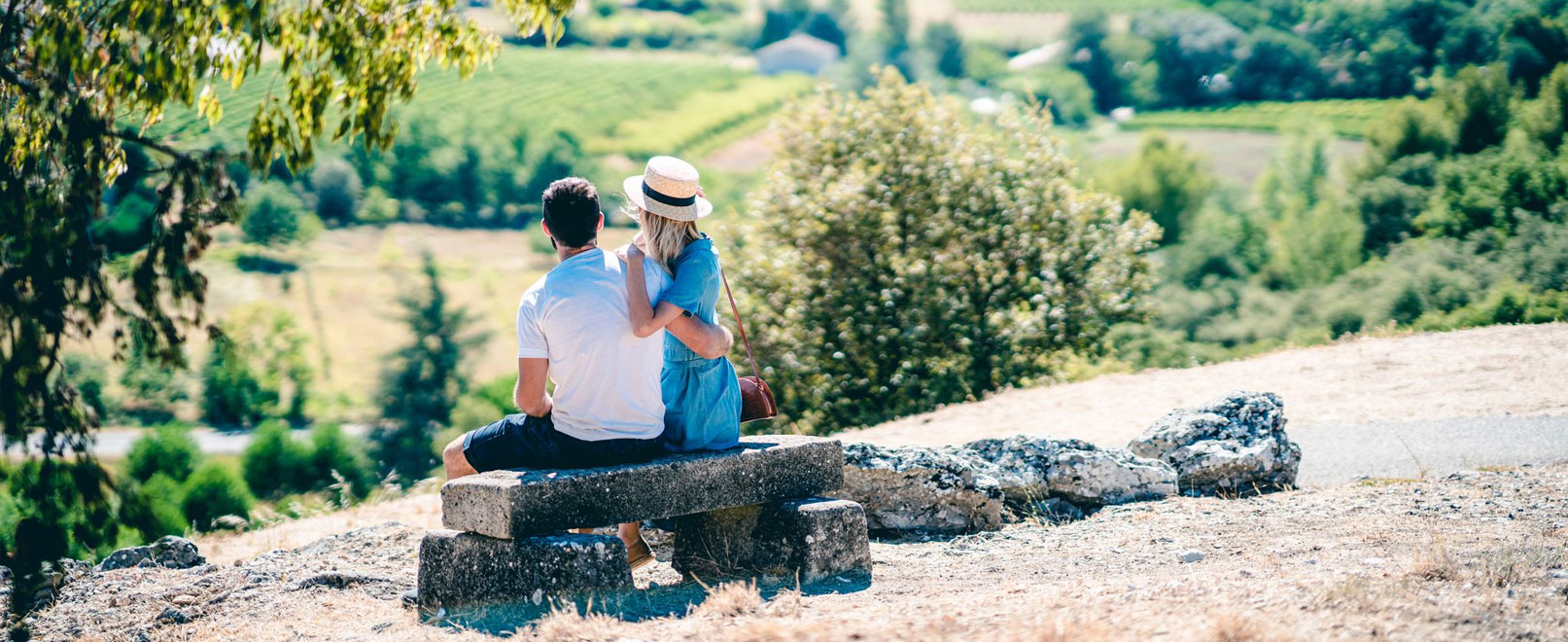
Discover Vaucluse without a car!
By utilising public transport
You can travel around Vaucluse while your car stays at home! Whether it’s travel by train, bus, or even boat, we’re switching into sustainable mode. It’s time for an adventure that benefits the planet and that minimises carbon impact.
Day 1 – RHÔNE VALLEY
2 possible end points: Bollène or Orange, according to your preference.
Option 1: arrival in Bollène
At the SNCF station, take the Bollène urban transport line no. 2 into the city. Explore the city by following either the historic route around the lower city or the medieval route around the upper city, which leads you to the Collegiate Church of Saint Martin with its panoramic view of the Rhône Valley and the Cévennes (details of the routes can be found at the tourist office).
From Bollène, you can also embark upon a day trip to Mornas, where you can visit the medieval fortress (guided tours available in season) which towers over the village and offers views of the surrounding countryside all the way from the Rhône Valley to Ventoux! For this excursion, take line 1 Bollène-Orange.
Option 2: arrival in Orange
Travel to the city centre on foot or by using lines 1 and 2 of the TCVO urban transport system, which link the the SNCF train station and the Cours Pourtoules in the heart of the city.
Named the city of princes, Orange has flourished since antiquity and was named a Unesco World Heritage site in 1981.
It was here that the Romans built a theatre with a capacity of 10,000 people, and today its stage wall still stands and is one of the best preserved in the world. It has even been praised by Louis XIV, who stated that it was the “Most beautiful wall in [his] kingdom”. In the north of the town the majestic triumphal arch, a symbol of Roman supremacy both on land and on sea, takes centre stage, and stands as an honorary passage between the ancient city and the land of the dead.
Our tour of the ancient city ends with the Museum of Art and History, where mosaics, cadastral maps, ancient remains and other objects act as a testimony to the significant position held by Orange during the Roman epoch.
From Orange, the Zou line no. 922 allows for a day trip to Châteauneuf-du-Pape, where you can enjoy the city’s attractive streets and the remains of its castle and grand estates.
Note that from Orange, you can escape on a getaway to the Papal Enclave by taking the Zou line no. 903 which connects the City of Princes to Valréas.
In the evening, head for Avignon central station, taking the TER line from Orange or Bollène.
Day 2 – Avignon (and its surroundings)
The Papal city welcomes you! Explore the Pope’s Palace, the “Petit Palais”, the Doms garden, the Saint-Bénézet bridge, the museums, picturesque streets and squares (rue des teinturiers, rue Peyrolerie, place des Corps saints, place Saint Didier, place de l’Horloge…), and stroll through time as you discover the town’s history and enchanting stories.
Auf der anderen Rhône-Seite erwartet Sie Villeneuve-lez-Avignon zu einem Besuch seines Fort Saint-André, des Kartäuserklosters mit seinen Gärten und dem Turm Philippe-le-Bel.
Sie gelangen mit der Linie 5 des Orizo-Netzes ganz leicht in 11 Minuten dorthin.
From the other side of the Rhône, Villeneuve-lez-Avignon beckons to you, inviting you to visit the Saint-André Fort, the Chartreuse monastery and its gardens, and the Philippe-le-Bel tower. It’s an easy journey on line 5 of the Orizo network, taking just 11 minutes.
If you’ve brought your sea legs with you, the Grands Bateaux de Provence allow you to discover the most beautiful structures of Avignon and Villeneuve-lez-Avignon (The Avignon Bridge, the Popes’ Palace, Le Rocher des Doms, the Eiffel bridge, l’île de la Barthelasse and l’île Piot, Villeneuve-lez-Avignon and the Philippe le Bel tower) during a boat trip down the river Rhône. Also available are discovery cruises that include lunch or dinner.
To note: the regional Zou! network also provides access to the small towns surrounding Avignon.
In the evening, head to Carpentras by TER or bus, and prepare for your trip to the Ventoux region.
Useful information: (french)
Days 3 and 4 – Around Mont Ventoux
Carpentras, capital not only of the Comtat Venaissin, but also of strawberries and of the berlingot candy, is the first of many stops dotted around the giant of Provence.
The history of the city is told in many ways: through the Inguimbertine Library-Museum (once a general hospital, which now houses both ancient collections and trendy digital devices), the first-century Roman arch, the Saint-Siffrein Cathedral (15th century), the 14th-century Synagogue (the oldest active synagogue in France), the Boyer Passage (a shopping street crowned by a glass roof), the Halles shopping arcades, the Porte d’Orange (14th century), the Belfry and more.
And on Fridays, when the market takes over the streets and squares, the multitude of scents and colours adds to the charm of the city.
We complete our visit by discovering how to make berlingots, pure sweetness in the form of a triangular pyramid, with various flavours including mint, lemon, aniseed, coffee, and strawberry.
From the town, the Trans’Cove intercommunal transport and regular Zou! bus line services grant access to picturesque villages whose history is intimately linked with Ventoux, the Dentelles de Montmirail in the “Pays de Sault” and the Vaison-Ventoux region. Discover these villages at your own pace, not forgetting to pay attention to the lavender fields, olive trees, cherries or truffles…
You can also head to Pernes-les-Fontaines to behold its 41 fountains, the Ferrande tower, and its craftspeople at work (one of our unmissable experiences😉 ) via Zou line no.913.
For a fun day by the water’s edge or in the realm of comics, head by bus (line 905 Carpentras- Avignon) to Monteux, where you will find the Monteux-Provence lake (with leisure park with pedalos, paddle boards, kayaks, “Funny Jumpy” inflatable water obstacle course, and more!), the Spirou Theme park, and Wave Island.
Want to walk in the footsteps of the Romans?
Head in the direction of Vaison-la-Romaine on Zou line no.911, and discover the antique sites of Puymin and la Villasse. Then cross over the Roman bridge to reach the medieval town. You won’t forget this journey through time any time soon!
If you’re a lavender enthusiast, than hop on Zou line 912 and head to the Pays de Sault. The fields are waiting for you! The famous lavender field in front of the village of Aurel can be reached by taxi.
This programme around Ventoux is certainly jam-packed, featuring everything from nature walks to heritage sites to theme parks!
To reach l’Isle-sur-la-Sorgue and Cavaillon, the next stages of the trip, take Zou line 913.
Useful information: (french)
- Line L : Bedoin, Caromb, Crillon-le-Brave
- Line K : Malaucène, Le Barroux
- Line M : Flassan, Mazan, Mormoiron (and the lake “les Salettes”, that can be reached on foot)
- Line N : Venasque (classed as one of the most beautiful villages in France), Saint-Didier (with an opportunity to try Silvain nougat), le Beaucet
- Line J : Beaumes-de-Venise, Lafare and Suzette,Vacqueyras, Gigondas, Sablet, Séguret (classed as one of the most beautiful villages in France) and wine country (enjoy in moderation😉 ).
- Schedule for the Carpentras / Pernes-les-Fontaines line no. 913
- Schedule for the Carpentras / Monteux line no. 905 (To spend a day at Wave Island or the Spirou theme park)
- Schedule for the Carpentras / Vaison-la-Romaine line no. 911
- Schedule for the Carpentras / Sault line no. 912
- Schedule for the Carpentras / Isle-sur-la-Sorgue line no. 913
Days 5 and 6 – Heading to northern Luberon
First stop: L’Isle-sur-La-Sorgue. Nicknamed the “Venice Comtadine”, this old fishing village gets its unique charm from its small bridges, its water wheels, and its canals which are the perfect place for an afternoon stroll.
Add on the many antique shops (the city is the 3rd best European antiques destination), pretty houses, and the colourful Sunday morning market and your portrait of this small city is complete.
From the heart of the city, you can reach Fontaine-de-Vaucluse and its mythical spring, via Zou line 921 from July to August, or by renting a bike or by taxi during the rest of the year.
For a visit to Châteauneuf-de-Gadagagne (birthplace of the Félibrige) and Thor (with its pretty town centre, caves and the Château de Thouzon), take Zou line 906.
Then head in the direction of Cavaillon, taking Zou line 913.
Located at the foot of the St Jacques hill by the river Durance, Cavaillon, the melon capital of the world (Alexandre Dumas was an avid enthusiast of the fruit), possesses treasures which evoke the Greek, Roman and episcopal history of this city that lies between Alpilles and Luberon. The first century arch, the 14th century synagogue, the 12th century cathedral, the Evêché (bishop’s house), the Agar Hotel (a cabinet of curiosities built on the remains of Roman baths) and the 18th century general hospital stand as testimony to the city’s past.
Fancy a nature-based getaway? Explore the Via-ferrata above the city and the numerous cycling, hiking and climbing trails from the city centre.
As you head in the direction of Apt, you can reach some of the most beautiful villages in Vaucluse: Gordes and Roussillon, classed as among the most beautiful villages in France, Bonnieux, Oppède, Ménerbes (classed as among the most beautiful villages in France), Lacoste (home of the Marquis de Sade) and finally Apt, your next destination.
Apt, a historical city located at the heart of the Luberon ochre massif, and the world capital of candied fruit, invites visitors on a journey from Roman times to the industrial era with the Maison du fruit confit, the France Ochre Society and the Apt Museum.
From the town, the “pays d’Apt Luberon” can be reached via Zou line 909 , home to the towns of Auribeau, Buoux, Joucas, Murs, Roussillon (and its ochre trail), Rustrel (the Provencal Colorado is located about 2km from the town), Saignon, Saint-Saturnin-lès-Apt, Sivergues and more.
There are two ways of getting to South Luberon and La Tour d’Aigues:
– Departing from Apt and heading for South Luberon, take Zou line 909 to Cadenet, then Zou line 908 to Pertuis and finally Zou line 923 to La Tour d’Aigues
– Return to Cavaillon, then take the Zou line 908 to Pertuis, then Zou line 923 to reach La Tour d’Aigues.
Useful information (french)
- Schedule for the Isle-sur-la-Sorgue / Cavaillon line no.913
- Zou line 917 : Gordes and Roussillon classed as among the most beautiful villages in France, Bonnieux
- Line 921 : Isle-sur-la-Sorgue / Fontaine de Vaucluse
- Line 906 : Isle-sur-la-Sorgue / Châteauneuf-de-Gadagne / Le Thor
- Line Zou 918 : Oppède, Ménerbes (Roussillon classed as among the most beautiful villages in France), Lacoste (home of the Marquis de Sade) and Apt, your next destination.
- Zou line 909 : Auribeau, Buoux, Joucas, Murs, Roussillon (and its ochre trail), Rustrel (the Provencal Colorado is located about 2km from the town), Saignon, Saint-Saturnin-lès-Apt, Sivergues…
- Schedule for the Apt / La Tour d’Aigues line with stops at Cadenet on Zou line 909, Pertuis on Zou line 908 and finally La Tour d’Aigues on Zou line 923.
- Schedule for the Apt / La Tour d’Aigues line from Cavaillon, taking Zou line 908 to Pertuis, then Zou line 923 to get to La Tour d’Aigues.
Days 7 and 8 – South Luberon
La Tour d’Aigues, situated on the banks of the river Eze and surrounded by vineyards and olive trees, presents visitors with a lovely renaissance chateau and plenty of other little treasures: the Saint Christopher Chapel, the Notre dame de Romegas church, the wash house, the alleys and small squares where the balusters, oratories and other carved decorations can be admired. The historical route takes a more festive turn on Tuesday mornings when the market bursts into life on the Chateau esplanade.
With Zou line 983 (reservation required) you can discover the villages of the Pays d’Aigues: Beaumont-de-Pertuis, Cabrières-d’Aigues, Grambois, La Bastide des Jourdans, La Bastidonne, La Motte d’Aigues, Mirabeau, Peypin-d’Aigues, Saint-Martin-de-la-Brasque, Vitrolles-en-Luberon.
Lourmarin and Ansouis (classed as among the most beautiful villages in France), Cucuron, Lauris, Puyvert or even Villelaure are accessible via Zou line 908.
Your sustainable trip around Vaucluse is now complete (all good things must come to an end 😉)!
To set off back home, head for the Pertuis SNCF station, which will take you back to Aix-en-Provence and the Saint-Charles de Marseille station.
Useful information (french)
- Booking for Zou line 983 in order to visit the Pays d’Aigues
- Schedule for Zou line 908 and 919 for your visit to Lourmarin, Ansouis, Cucuron, Lauris, Puyvert or Villelaure
Useful information

Useful websites
Interactive Zou map, all schedules in real time
SNCF (for getting to Vaucluse)
Zou Railways in Provence
Avignon and around lines (Orizo)

Zou ! M Ticket App: buy your tickets online and access them from your smartphone
